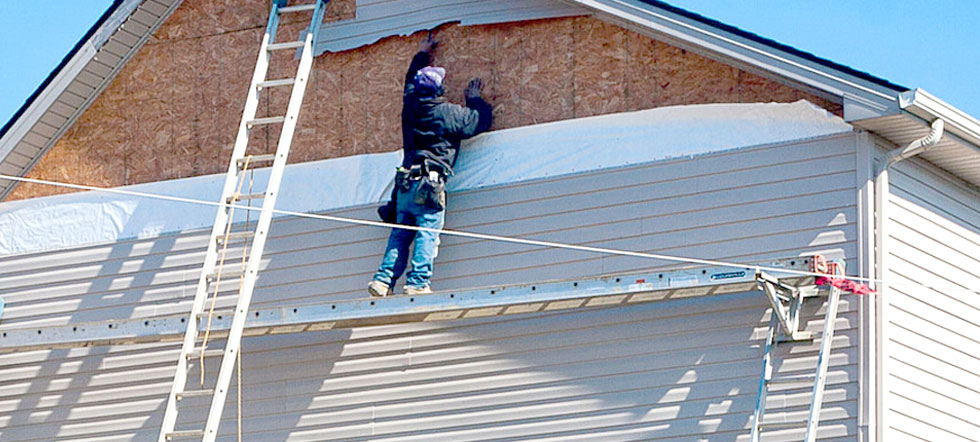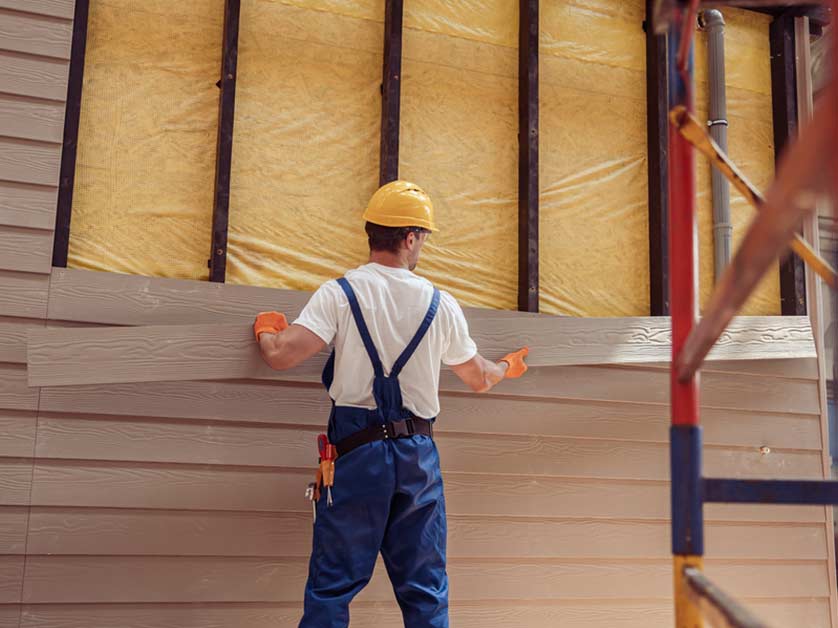The Necessary Overview to the Different Kinds Of Exterior Siding and Their Unique Benefits
In the realm of home enhancement, choosing the ideal home siding is an essential decision that impacts both aesthetic appeal and practical performance. With so lots of alternatives to take into consideration, which siding material really stands out for your particular project?
Wood Siding
Timber house siding, a popular choice for domestic exteriors, provides a timeless aesthetic that incorporates natural elegance with structural integrity. This home siding material is offered in numerous designs, consisting of clapboard, shingles, and board-and-batten, allowing homeowners to tailor their appearance to match their design choices. Timber exterior siding is normally crafted from long lasting species such as cedar, redwood, or ache, which are understood for their durability and ability to withstand ecological stress factors.
Among the main benefits of wood home siding is its excellent insulation properties, which can add to power performance and lower heating prices. Additionally, timber home siding is eco-friendly, making it an eco-friendly option when sourced sustainably. Regular maintenance, consisting of paint or discoloration, can lengthen its lifespan and enhance its look, allowing home owners to preserve the all-natural beauty of the wood.
Nonetheless, potential disadvantages include sensitivity to bugs, rot, and weather condition damages, requiring sufficient treatment and upkeep - morris siding contractor. In spite of these worries, when effectively taken care of, wood home siding can offer a durable and attractive option that boosts the character of a home while providing a cozy, welcoming ambience

Plastic Home Siding
Vinyl siding has actually emerged as a leading selection for home owners seeking a low-maintenance exterior option that combines sturdiness and cost. This flexible material is crafted from polyvinyl chloride (PVC), making it resistant to various weather conditions, consisting of dampness and UV rays. As an outcome, plastic siding does not warp, rot, or discolor, making certain resilient visual charm.
Among the primary advantages of plastic exterior siding is its extensive series of colors and styles, permitting house owners to achieve the preferred search for their residential or commercial property without the demand for frequent repainting. Furthermore, vinyl house siding is simple to install, which can dramatically lower labor expenses during building and construction or improvement tasks.
Plastic siding additionally adds to energy efficiency. Several alternatives feature insulation backing, which enhances thermal efficiency, helping to keep comfortable indoor temperature levels and possibly reducing energy bills. Its smooth surface assists in easy cleansing, requiring only periodic cleaning with a yard pipe to eliminate dirt and particles.
Fiber Cement Exterior Siding
Fiber concrete home siding has actually gained grip among builders and homeowners alike because of its amazing mix of sturdiness and aesthetic adaptability. Made up of a mixture of cellulose, sand, and concrete fibers, this home siding alternative is engineered to stand up to extreme weather, consisting of high winds, hefty rainfall, and temperature changes, making it a long-lasting selection for residential outsides.

Among the key benefits of fiber cement home siding is its resistance to pests, such as termites, and its non-combustible nature, offering enhanced fire safety and security. morris siding contractor. Additionally, it is offered in a large range of appearances, colors, and designs, enabling property owners to attain their desired visual without sacrificing efficiency
Another benefit is its reduced maintenance needs; fiber cement house siding generally requires painting or discoloration every 5-10 years, which is much less frequent than various other products. Additionally, its long life contributes to a lower total price of ownership, as it decreases the demand for regular repair work or substitutes.
Inevitably, fiber concrete exterior siding represents a superb investment for those seeking a durable, appealing, and functional outside option, incorporating both form and function to enhance the home's visual charm.
Metal Exterior Siding
The allure of steel house siding exists in its durable resilience and contemporary aesthetic appeal, making it a popular choice for modern style. Readily available in products such as light weight aluminum and steel, steel house siding provides a series of coatings and colors, permitting homeowners to achieve a personalized appearance that enhances their layout vision.

Energy performance is another substantial benefit, as numerous steel siding items are designed with insulation alternatives that help control interior temperature levels. This can lead to decreased energy prices over time. Furthermore, steel house siding is typically recyclable, making it an eco-friendly selection for sustainability-minded property owners.
The setup procedure for metal home siding can be relatively uncomplicated, leading to a quicker turnaround time for building and construction projects. In general, steel siding integrates capability and style, making it a useful option for those looking for website link a visually enticing and long-lasting exterior finish.
Brick and Rock House Siding
Block and stone exterior siding sticks out as an ageless option that enhances the aesthetic charm of any home. Known for their toughness and reduced maintenance, these products give an exceptional return on investment while elevating the building's curb allure. Available in numerous shades, textures, and patterns, brick and stone can be customized to match varied architectural designs, from typical to modern-day.
One of the key benefits of brick and stone house siding is their energy performance. Both products possess all-natural shielding residential properties that help control interior temperatures, possibly minimizing cooling and heating Check This Out costs. Furthermore, they use exceptional fire resistance compared to other home siding alternatives, adding to improved security.
An additional benefit is their longevity. Brick and stone can last for decades, often requiring very little upkeep beyond periodic cleansing. Unlike timber siding, they are invulnerable to parasites and rot, guaranteeing a durable outside that endures the aspects.
Verdict
In recap, the selection of home siding significantly affects a home's visual allure, energy performance, and maintenance needs. Each kind of home siding-- whether timber, vinyl, fiber block, cement, or metal and rock-- offers distinct advantages customized to various house owner choices and ecological problems. Recognizing these choices allows informed decisions that enhance both the resilience and visual beauty of property exteriors. Eventually, choosing the right house siding is essential for attaining an equilibrium between functionality and layout in household design.
One of the main advantages of timber home siding is its superb insulation residential properties, which can contribute to energy efficiency and lower heating expenses. Additionally, wood home siding is biodegradable, making it an ecologically pleasant option when sourced sustainably.One of the main advantages of metal home siding is its resistance to various environmental variables.Energy effectiveness is an additional substantial advantage, as lots of steel exterior siding items are made with insulation choices that aid regulate interior temperature levels. Each type of home siding-- whether timber, vinyl, fiber metal, cement, or block and stone-- supplies special benefits tailored find more to numerous house owner preferences and environmental conditions.